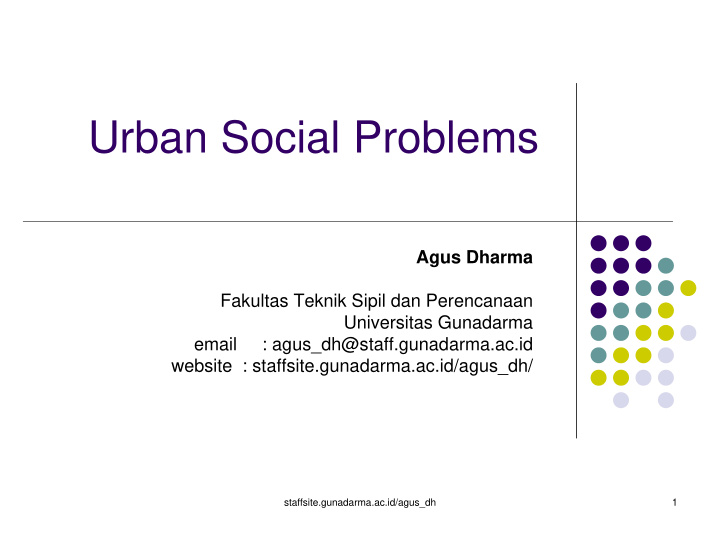



Urban Social Problems Agus Dharma Fakultas Teknik Sipil dan Perencanaan Universitas Gunadarma email : agus_dh@staff.gunadarma.ac.id website : staffsite.gunadarma.ac.id/agus_dh/ staffsite.gunadarma.ac.id/agus_dh 1
Urban Problems � The urban movement � From rural to cities � Today ½ of the world lives in cities � City- a large # of people who live in one place and do not produce their own food � Cities designed to solve problems � Community- feeling of belonging staffsite.gunadarma.ac.id/agus_dh 2
� Almost all social problems are “urban” � City life increases social problems � Middle class moving to suburbs � Urban sprawl � Urban crisis staffsite.gunadarma.ac.id/agus_dh 3
Symbolic Interactionism � How life looks to the people who live it � The Chicago school of sociology : People of different backgrounds live in separate areas and develop unique subcultures � William Foote Whyte : city = tightly knit way of life Each group has own statuses, norms, and ways of controlling its members staffsite.gunadarma.ac.id/agus_dh 4
� Gerald Suttles : Each group had its own form of communication � Elijah Anderson : - Boundaries between “us” and “them” - Neighborhoods being “gentrified” - In urban settings- people stake out territory, establish social boundaries between themselves and others, and develop a sense of ID and belonging staffsite.gunadarma.ac.id/agus_dh 5
Functionalism Ernest Burgess : how cities grow � Five zones - City expands outward from its center : - Zone I- central business district - Zone II- encircles downtown area (incl. slums) - Zone III- working men and women escape slums - Zone IV- better apts., single family residences, the wealthy live there staffsite.gunadarma.ac.id/agus_dh 6
� Zone V- commuter zone of suburbs beyond city limits � City dwellers are always on the move � Move into better zones when they can afford to � Invasion-succession cycle � The most mobile areas have the most severe social problems � Mobility and problems concentrated in zone II (zone in transition) � A city’s problems are transitory staffsite.gunadarma.ac.id/agus_dh 7
Conflict theory � Class conflict- capitalism � Business leaders dictate gov’t policy and tap the public treasury � Increase profits of developers � Finance transportation system to move goods the wealthy manufacture � Corporate leaders abandoned areas they no longer needed to the poor staffsite.gunadarma.ac.id/agus_dh 8
Intimacy of city life � Gemeinschaft � Gesselschaft � Diffusion of responsibility � City provides community � Network of friends/acquaintances � City divided into little worlds staffsite.gunadarma.ac.id/agus_dh 9
� Five types of urban dwellers � The cosmopolites � The singles � The ethnic villagers � The deprived � The trapped � Skid row- trapped/deprived live here (area of bars, cheap restaurants, pawnshops, and rescue missions) staffsite.gunadarma.ac.id/agus_dh 10
Decline of central city � Suburban sprawl � Capitalists- redlining � Bankers and disinvestment � Abandonment � Arson staffsite.gunadarma.ac.id/agus_dh 11
Urban violence � Gangs � Supergangs � Girl gangs � School violence � Riots � Communal riots � Commodity riots staffsite.gunadarma.ac.id/agus_dh 12
Emerging megalopolis � Supermetropolitan unit � Interconnected areas � Regional planning � Edge cities � restratification staffsite.gunadarma.ac.id/agus_dh 13
Educating the poor � Teachers, teaching methods � Small class size � Work study programs � Scholarships � Social promotion � Functional illiteracy staffsite.gunadarma.ac.id/agus_dh 14
Recommend
More recommend